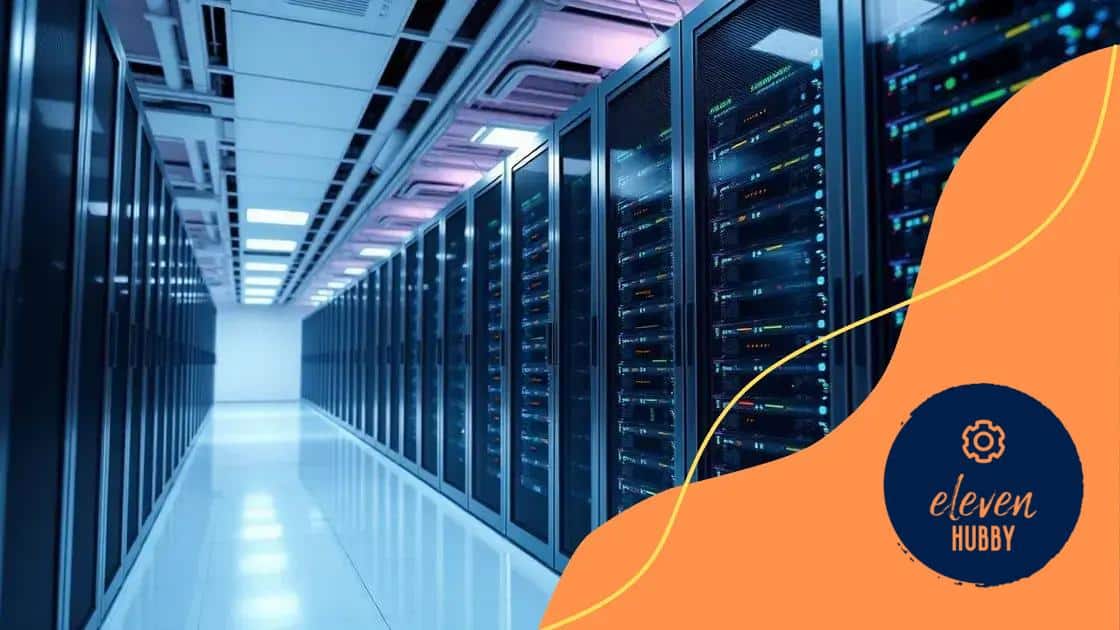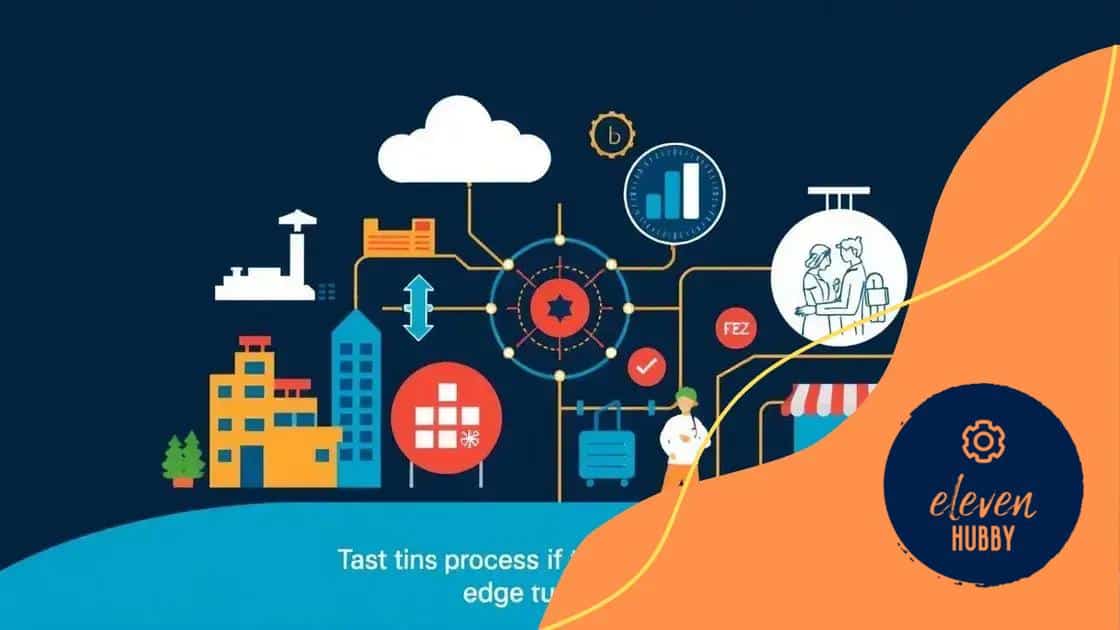The rise of edge computing in enterprise solutions

The rise of edge computing in enterprise solutions improves data processing speed, enhances security, and supports real-time decision-making by bringing computation closer to the data source, making it essential for modern businesses.
The rise of edge computing in enterprise solutions is changing how organizations operate. By bringing data processing closer to the source, companies gain speed and efficiency. Have you thought about how this might impact your business?
Understanding edge computing
Understanding edge computing is essential as it reshapes how businesses handle data. By processing information closer to where it is generated, companies can achieve faster response times and reduced latency.
What is Edge Computing?
Edge computing refers to the practice of processing data near the source, rather than relying on a centralized data center. This can significantly improve efficiency and enable real-time analytics.
Key Features of Edge Computing
- Low latency due to proximity to data sources.
- Improved bandwidth usage.
- Enhanced security as data does not need to travel far.
- Scalability for increasing data loads.
Businesses are leveraging edge computing in various ways. For instance, in smart manufacturing, machines are equipped with sensors that generate data on the production floor. This data is analyzed instantly, allowing for immediate adjustments and reducing downtime.
The ability to make real-time decisions can transform operations. By monitoring customer interactions via edge devices, companies can personalize experiences quickly. This means better service and increased customer satisfaction.
Advantages Over Traditional Models
Using edge computing has distinct advantages over traditional cloud-based models. For one, it minimizes the time it takes to send data to a distant server and get a response back. Moreover, it alleviates network bandwidth pressures since less data needs to be sent back and forth.
- Faster operations lead to enhanced user experiences.
- Lower operational costs due to reduced bandwidth usage.
- Greater data security as sensitive information stays closer.
As technology continues to evolve, edge computing is becoming more accessible. This shift represents a significant paradigm change for industries across the board. The future holds exciting possibilities for businesses eager to optimize their processes and enhance service delivery.
Key benefits for enterprises
There are many key benefits of adopting edge computing for enterprises. These advantages can lead to increased efficiency and improved operations.
Faster Data Processing
One major benefit of edge computing is faster data processing. By processing data locally, businesses can achieve quick insights and respond to changes instantly. This speed is vital for applications like autonomous vehicles and industrial automation.
Enhanced Security
Another important advantage is enhanced security. With less data being sent to centralized servers, the risk of data breaches decreases. Sensitive information stays closer to the source, reducing exposure.
- Local data processing limits access to sensitive data.
- Improved data compliance with regulations.
- Enhanced threat detection and response times.
Edge computing also promotes efficient bandwidth usage. As companies generate significant amounts of data, sending it all to the cloud can overwhelm networks. Instead, edge devices can filter and relay only critical information.
This selective data transmission optimizes network performance and reduces costs associated with data transfer. Additionally, businesses can save on cloud storage expenses, as less data needs to be uploaded.
Improved Reliability
Improved reliability is another substantial benefit. Edge computing systems can continue functioning even when cloud connectivity is intermittent. This ensures that operations are not halted due to network disruptions, offering greater operational continuity.
- Minimized downtime during outages.
- Seamless operations for mission-critical applications.
- Resilient systems that adapt to local conditions.
In summary, organizations that leverage edge computing can not only enhance speed and security but also enjoy greater reliability and cost benefits. These factors can significantly affect competitiveness in an increasingly digital world.
Real-world applications in business

Edge computing is increasingly prominent across various industries. Its real-world applications enhance efficiency and innovation in business operations.
Manufacturing
In the manufacturing sector, edge computing enables smart factories to operate efficiently. Machines equipped with sensors gather data about production processes, which is analyzed locally. This allows for quick adjustments, reducing downtime significantly.
Healthcare
The healthcare industry also benefits from edge computing. Wearable devices collect patient data in real-time. By processing this data locally, doctors can make immediate decisions about treatment, improving patient outcomes. The speed of edge computing is critical for applications like remote monitoring.
- Immediate data analysis enhances decision-making.
- Efficient use of resources and improved patient care.
- Secure handling of sensitive health information.
In the retail sector, businesses use edge computing to optimize inventory management. By analyzing sales data on-site, retailers understand consumer behavior better, adjusting stock levels in real-time. This helps businesses reduce waste and increase sales.
Additionally, edge computing supports smart cities. From traffic management to energy consumption, data is collected and processed locally. This enables faster responses to changing conditions, enhancing urban living.
Telecommunications
Telecommunications companies implement edge computing to improve services like 5G. By reducing latency and enhancing bandwidth, they provide users with seamless connectivity. This makes it possible to support a larger number of devices and improve the quality of experiences.
- Better user experiences with low latency services.
- Increased capacity for connected devices.
- Enhanced network reliability during high traffic.
In summary, businesses harnessing the power of edge computing enjoy improved efficiency, quick decision-making, and better service delivery across various sectors. These real-world applications demonstrate the technology’s transformative impact, making it a vital component of modern operations.
Challenges to consider
While edge computing brings numerous benefits, there are also challenges that businesses must consider. Understanding these potential obstacles is essential for effective implementation.
Integration Complexity
One significant challenge is the complexity of integrating edge computing with existing systems. Many enterprises have traditional IT infrastructure that may not be compatible with edge technologies. It requires careful planning and possibly new hardware to make everything work together smoothly.
Security Risks
Security is another crucial concern. With data being processed at various edge locations, the potential for data breaches increases. Companies must ensure that all devices are secured and follow strict security protocols to protect sensitive information.
- Implement end-to-end encryption for data.
- Regularly update software to prevent vulnerabilities.
- Train staff on security best practices.
Compliance with regulations can also be tricky. Companies need to navigate different regulations surrounding data privacy and security. This can vary significantly depending on the regions they operate in, which adds to the complexity of managing edge computing.
Additionally, maintenance and management of edge devices present their own set of challenges. With devices spread across various locations, ensuring they are functioning correctly can be difficult. Companies need dedicated teams to monitor and manage these devices, which can lead to increased operational costs.
Scalability Issues
Scalability is also a challenge. As the demand for data processing increases, businesses must ensure their edge computing solutions can scale accordingly. This requires careful consideration of infrastructure, as adding more devices can introduce latency if not managed properly.
- Plan for future growth when deploying edge solutions.
- Monitor performance to identify bottlenecks.
- Adopt scalable technologies that can grow with your business.
The challenges posed by edge computing can be significant, but with proper planning and strategies, businesses can overcome them. Staying ahead of these challenges is crucial for leveraging the full potential of edge technology.
The future of edge computing
The future of edge computing looks bright as technology continues to advance. Businesses are increasingly recognizing the potential of edge solutions to improve operations and enhance customer experiences.
Growth in IoT Integration
One significant trend is the growth of Internet of Things (IoT) devices. As more devices connect to the internet, the demand for edge computing will rise. This connection allows for faster data processing and immediate responses in various applications, from smart homes to industrial automation.
AI and Machine Learning at the Edge
Another exciting development is the integration of artificial intelligence (AI) and machine learning at the edge. By processing data locally, businesses can utilize AI algorithms to make real-time decisions. This capability leads to better analytics and enhanced automation across industries.
- Improved decision-making based on live data analysis.
- Enhanced customization of user experiences.
- Faster responses to changing conditions.
Furthermore, advancements in 5G technology will significantly impact edge computing. With faster speeds and lower latency, 5G will facilitate more efficient data transmission between edge devices and centralized systems. This improvement will enhance applications such as remote surgeries, real-time traffic management, and immersive augmented reality experiences.
As businesses adopt these technologies, they must also focus on developing robust security measures. With the increased number of connected devices, securing data at the edge becomes crucial. This focus on security will shape future strategies in both edge computing and IoT.
Decentralized Infrastructure
Additionally, the shift towards decentralized infrastructure will become a key aspect of the future. Instead of relying solely on centralized data centers, organizations will harness edge networks to distribute workloads more effectively. This approach can lead to improved reliability and increased performance as data is processed closer to the source.
- Greater resiliency to outages.
- More efficient resource utilization.
- Enhanced scalability to meet growing demands.
The future of edge computing is set to redefine how businesses operate. By embracing these changes, organizations can unlock new opportunities and stay competitive in a rapidly evolving digital landscape.
In conclusion, edge computing is changing the way businesses operate by bringing data processing closer to the source. This technology offers various advantages, such as faster data analysis and improved security. As industries continue to integrate IoT devices and AI at the edge, the future is set to be more efficient and responsive. However, challenges like integration complexity and security must be addressed. By embracing these changes, organizations can unlock new opportunities and stay competitive in a rapidly evolving digital landscape.
FAQ – Frequently Asked Questions about Edge Computing
What is edge computing?
Edge computing is a technology that processes data closer to where it is generated, reducing latency and improving speed.
How does edge computing enhance security?
By processing sensitive data locally, edge computing minimizes the amount of data sent to centralized servers, lowering the risk of data breaches.
What applications benefit from edge computing?
Industries like manufacturing, healthcare, and retail use edge computing for real-time data analysis and improved operational efficiency.
What challenges does edge computing face?
Integration complexity, security risks, and scalability issues are some of the key challenges businesses must address when implementing edge computing.






